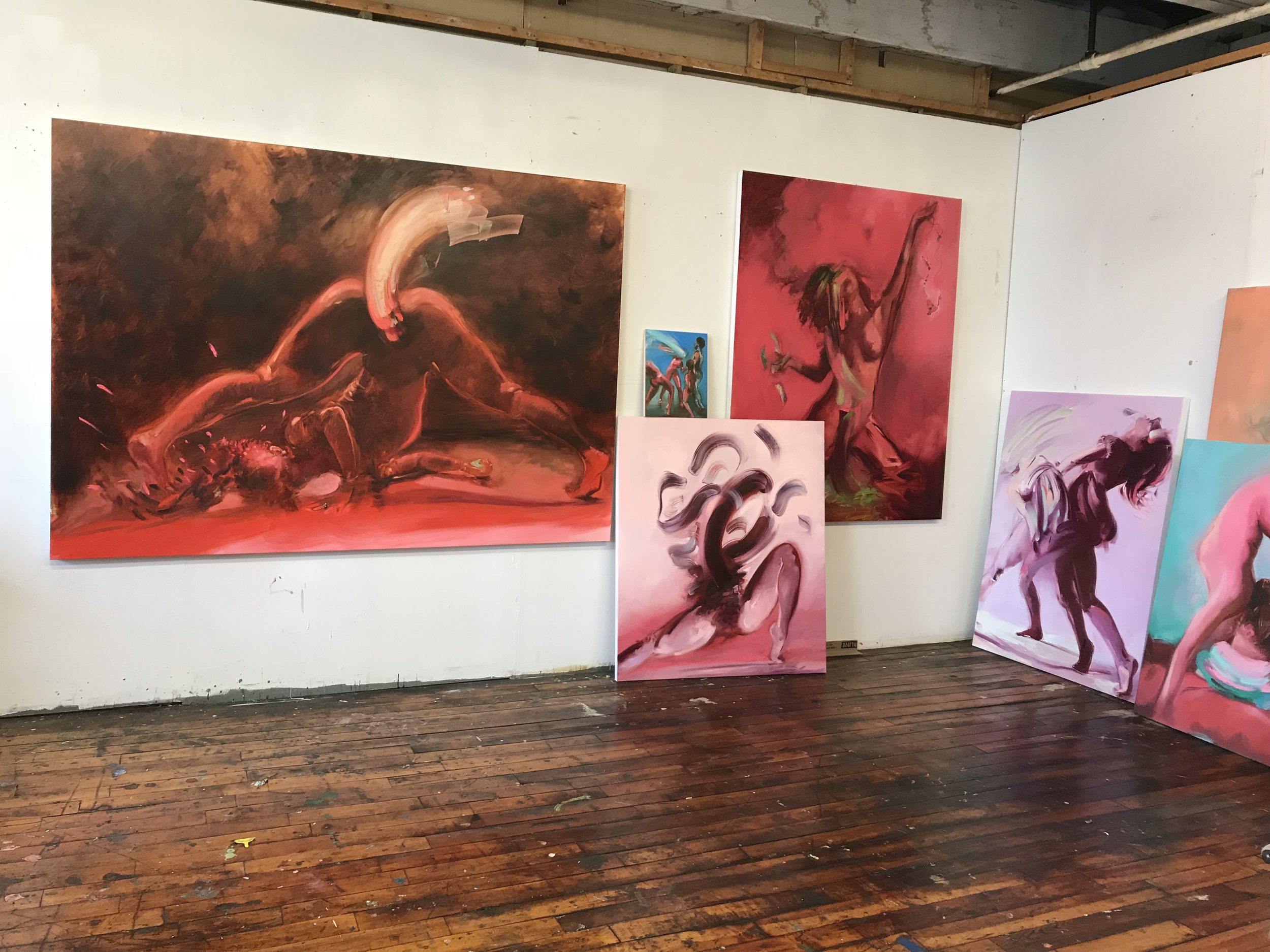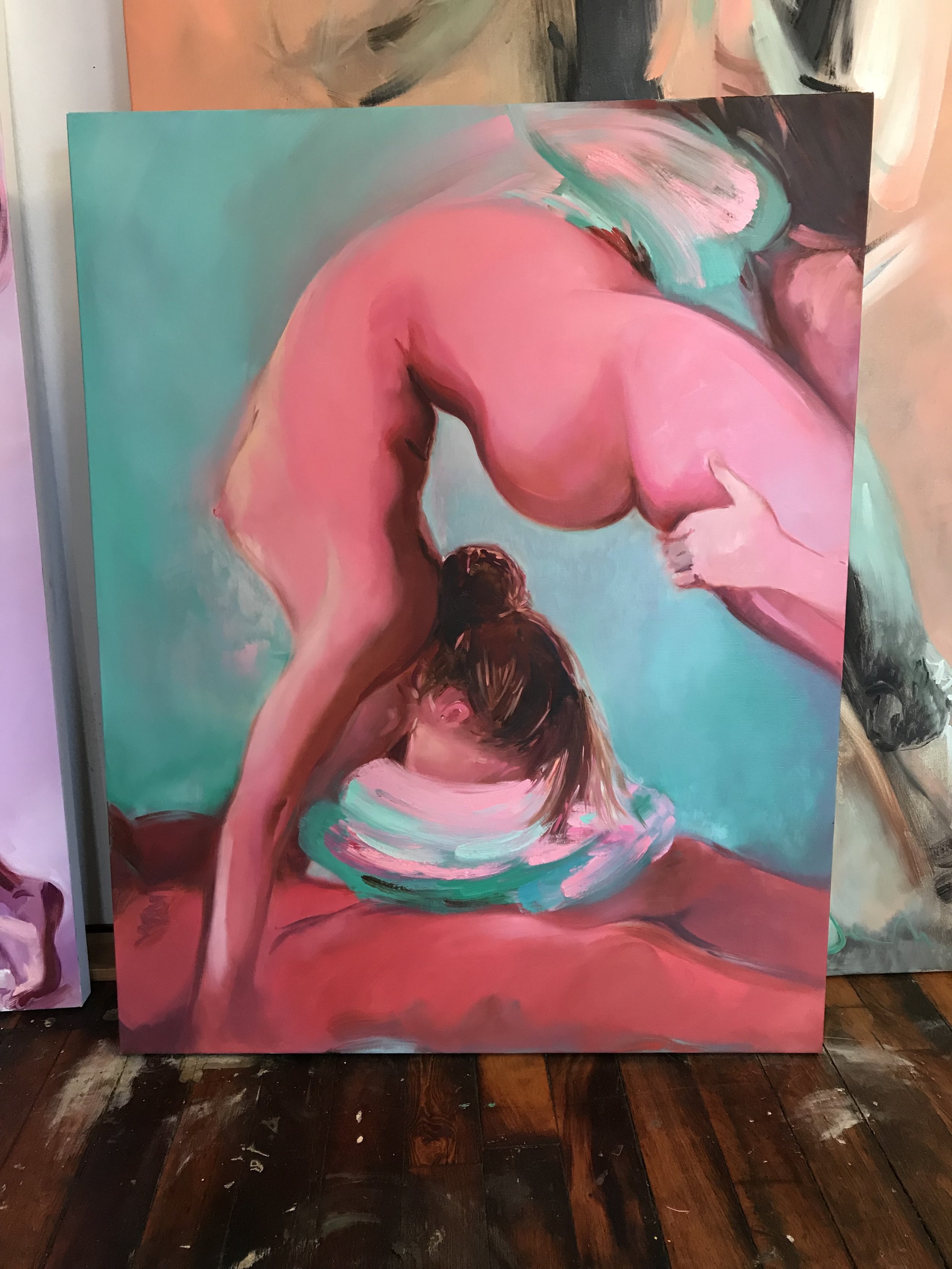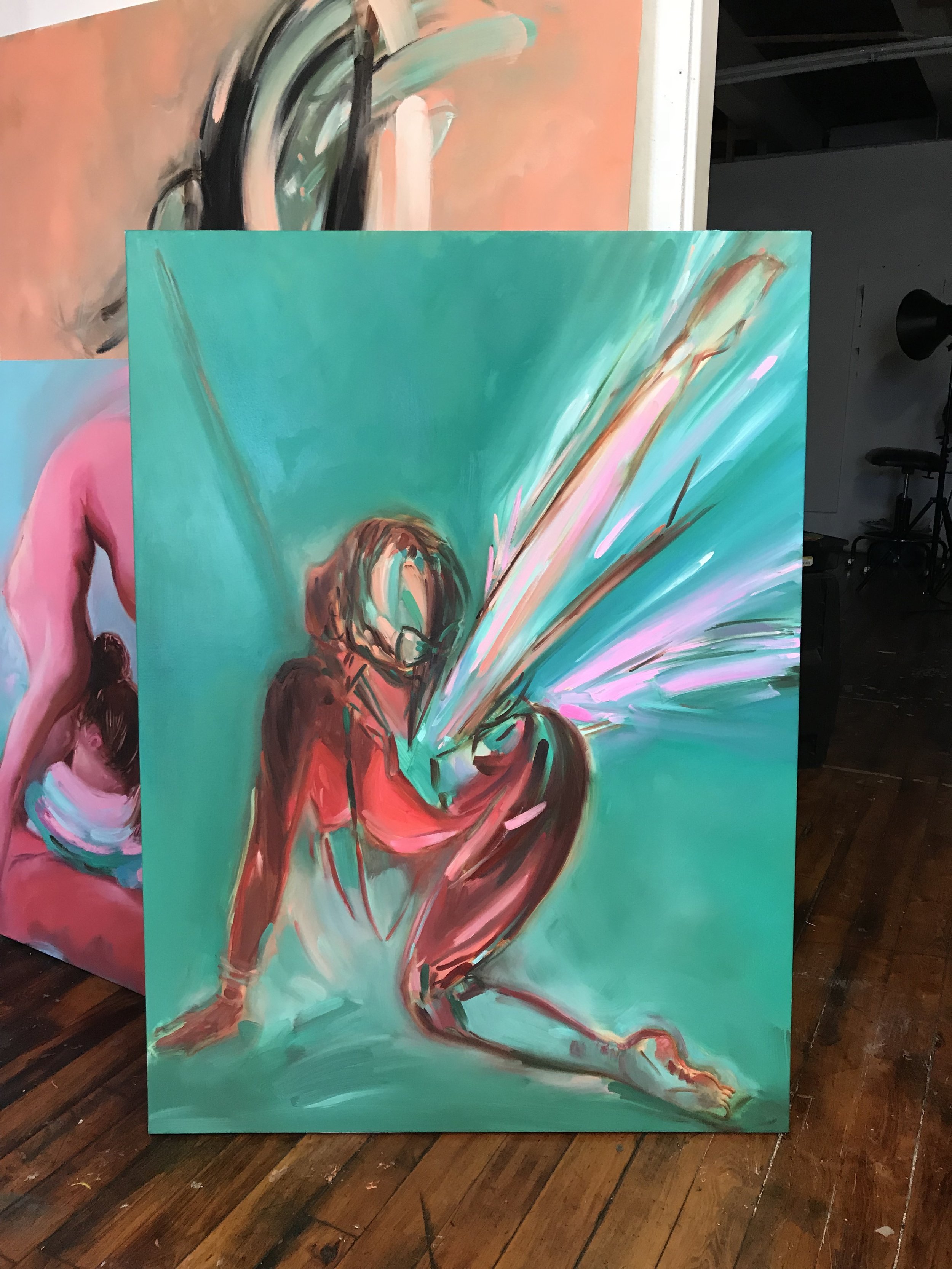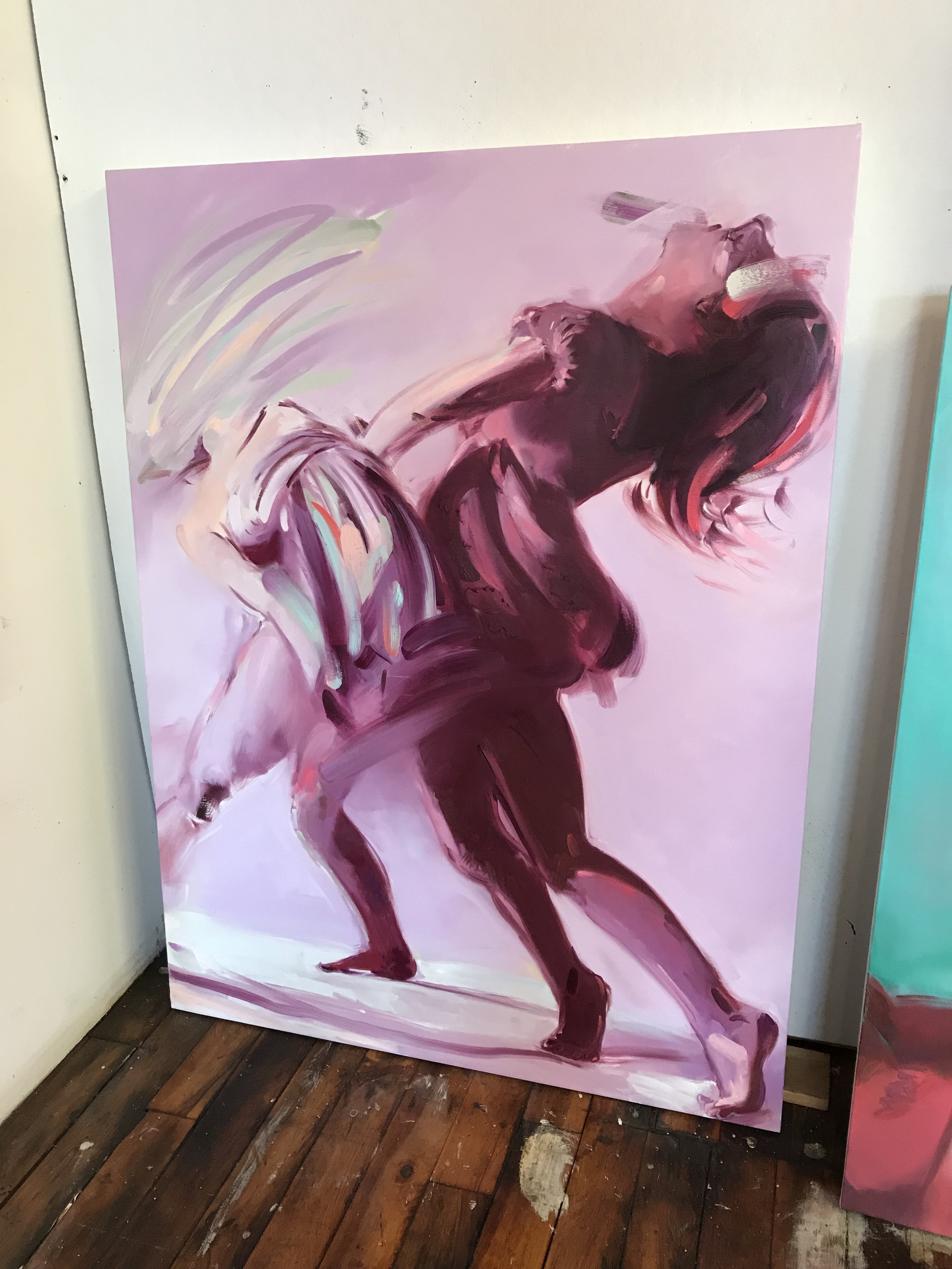As a gallery, we are constantly inspired by getting out of the gallery and seeing art. Every couple of months we have studio visits with our represented artists to see what projects they are working on. Many gallery visitors do not get the chance to visit an artist’s studio (although we always encourage it!), so here is a behind the scenes look into our time with our artist Ariel Basson Freiberg.

Ariel Basson Freiberg’s studio, Somerville, MA
Abigail Ogilvy Gallery: Thank you for hosting us, Ariel! To kick off our questions, let’s start with your schedule: What time of the day do you usually feel the most creative and do your best work? Do you stick to a regular schedule or paint whenever you have time?
Ariel Basson Freiberg: Typically, I’m in the studio four days a week. I find I work best when I have a large chunk of time. I’ll take several short breaks, but with an 8- to 16-hour day I can work with the whole surface of the canvas. I prefer to paint wet into wet so that I can make changes swiftly. It’s a balancing act scheduling time between my studio practice, my teaching schedule, and my responsibilities for the Post Baccalaureate program in studio art at Brandeis.
AOG: Do you have any daily routines that help your productivity? And/or any pre- or post-work rituals?

Ariel Basson Freiberg, Wasnowwhen, oil on linen, 42 x 34 in., 2016
ABF: Music is an important part of setting the tone for my studio activities. Lately, I’ve been gearing up with a mix of Felt, Grimes, Kate Bush, and the score for Sem Mim of Grupo Corpo. I also do some quick drawings to warm up before painting. I see mixing color as part of “the making” stage. I don’t really have any post-work rituals, except the obligatory brush clean up and most likely will take a photo or two of the latest works in progress.
AOG: What type/how many brushes do you use on average for each piece? Any other tools?
ABF: I use ten to thirty brushes, palette knives, scrapers, rags, and sometime brayers/rollers on the canvas and panels. I love bristle brushes for impasto painting and red stable and synthetic for smoother passages.
AOG: When you feel stuck, what do you do to become inspired again?
ABF: Inspiration is vast and complicated. The ritual of showing up in the studio is key for working through delays and hiccups. Sometimes a conversation with a partner, friend, or mentor will spark the fire. Sometimes, it’s going to see art by my favorites at one of the local museums. Other days, it’s reading poetry, like the collection Twerk by Latasha N. Nevada Diggs. I also mine dance performances for new ways of considering bodily gestures. I attend one or two dance classes a week, and I incubate the energy generated there for the studio.
AOG: Do you ever use models for your poses?
ABF: Sometimes I invite friends to model for me. I usually make drawings, which then may or may not be used in a future painting project. Most of the time I do not use models. My relationship with the canvas is very intimate, and I find it’s easier to work without having to worry about a model.

Ariel Basson Freiberg, Pegasus, oil on linen, 48 x 36 in., 2018
AOG: Your work is often considered bold and vibrant in terms of color palette. What colors inspire you to most? Do you perceive any specific colors in a certain way?
ABF: Vibrancy and color contrast are most inspiring for me. Fields of toxic green with a whiplash of pinks is forever seductive. Sometimes, I want the figures in my paintings to live deep in a mono-color world like in Standing Ovation. The moments of chromatic shifts occur in the accessories, and small adornments in and around the body pushed to an extreme posture. For me, color imbues a great deal of meaning. I draw many of my colors from amulets from my family heritage, fashion advertisements, the glam malls I grew up with in Houston, TX, and the landscape of my grandparent’s home in Ramat Gan, Israel.
AOG: You come from an Iraqi-Jewish heritage, have you visited Israel and if so, what did the visit(s) mean for you? How did they inspire you?
ABF: Most of my extended family currently live in Israel and Montreal. All of my family fled Iraq in the ‘50s and ‘70s. My family in Montreal kept close to their Iraqi identity, speaking their dialect all the time. My mom was only three years old, and my uncle eight days old, when they left Baghdad for Israel. As refugees from a Middle Eastern country, it was important for the youth to embody “Israeli” culture. Since the whole family had to revoke their Iraqi citizenships, they had to remake and modify themselves, from their names and language to their behavior to assimilate to their new home.
From a very young age, I would visit my family near Tel Aviv. It was the place I was always accepted and embraced. I loved the feel of the red clay soil on my feet and the dumplings my grandmother would make, along with the sweet milk and date cookies.
The will to make art is a feeble attempt at forging an understanding and unity between the high-contrast, surreal states of two disparate cultures: Texas and Iraqi Israeli. It took years to see how complicated our Iraqi identity was. It was privately fully embodied by my family yet publicly severed and veiled as much as possible. Only as a late teen did I realize I spoke two different languages when I thought I was only speaking Hebrew.
We were so grateful for the time spent at Vernon Street Studios with Ariel Basson Freiberg, thanks for having us!

Ariel Basson Freiberg, Standing Ovation, oil on linen, 56 x 78 in., 2018

Ariel Basson Freiberg, Double Twist, oil on linen, 48 x 36 in., 2018
Add a comment